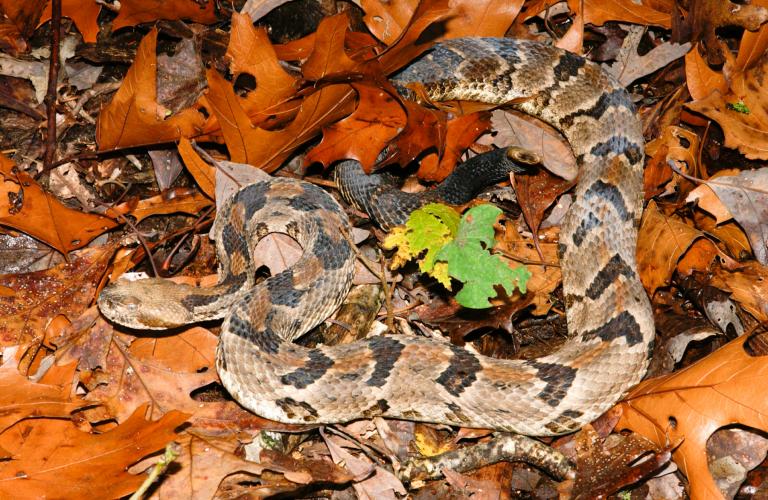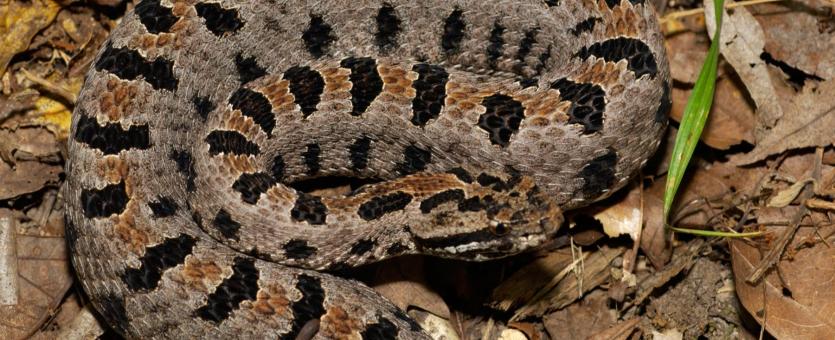Missouri is home to a variety of snakes, including five venomous pit vipers. Among these, three are rattlesnakes: the timber rattlesnake, the western pygmy rattlesnake, and the massasauga rattlesnake.
Rattlesnakes are often misunderstood animals, but they play an important role in keeping the ecosystem balanced. While their iconic rattles make them easy to identify, many nonvenomous snakes can be mistaken for pit vipers.
You are reading: Discover The 3 Types Of Rattlesnakes In Missouri
In this article, we will take a closer look at the three types of rattlesnakes in Missouri, including their physical characteristics, habitats, and behaviors.

3 Types Of Rattlesnakes In Missouri
Timber Rattlesnake

The Timber Rattlesnake, also known as the Canebrake Rattlesnake, is a venomous snake that can be found in various habitats in Missouri and the eastern United States. Here are some key characteristics and facts about this species:
– Appearance: Timber Rattlesnakes have a large, heavy body that can grow over 70 inches in length, although the average length is between 36-60 inches. They have a broad, flat, triangular-shaped head, colored yellow, tan, or gray, with a dark line running from each eye to the jaw. The main body color may be yellow, tan, brown, or gray, with darker V-shaped bands along the length of their bodies. Most timber rattlesnakes in Missouri also have an additional orange or rust-colored stripe running down the middle of their backs. Their bodies end with a “velvet-black” tail and a large, straw-colored rattle.
– Habitat: Timber Rattlesnakes prefer mature forests and heavily wooded, rocky, south- and southwest-facing hillsides near streams and rivers. They are often associated with large areas of rugged, hilly, heavily forested terrain with ledges and bluffs. In Missouri, they can be found in rock ledges and river bluffs, where they may congregate in overwintering dens with other snake species. They are also skillful climbers, scaling tall trees and bushes in search of prey.
– Behavior: Timber Rattlesnakes are generally shy and will remain motionless to avoid detection if encountered. They rely on their coloration to camouflage themselves among low bushes, branches, and dead leaves. When disturbed, they may quickly move away and try to escape or coil in a defensive posture and rattle. Male timber rattlesnakes engage in a special “combat dance” when they encounter each other, especially if a female is nearby, during the mating season.
– Activity: Timber Rattlesnakes are mainly active from April through mid-October. They bask on sunny rocks in spring and autumn, and in summer, they are mostly nocturnal. In Missouri, timber rattlesnakes begin courtship and mating mainly during the summer or early autumn, though some mating as early as late April has been reported.
Read more : Top 10 Funny Animal Names
– Threat Level: Timber Rattlesnakes are considered common and widespread, with no specific threat level identified. However, experts agree that the species is in trouble throughout most of its range, but its large size and venomous nature may preclude federal protection.
Western Pygmy Rattlesnake

The Western Pygmy Rattlesnake, also known as Strecker’s Pygmy Rattlesnake, is a venomous pit viper subspecies found in the southcentral United States. Here are some key characteristics and information about this species:
– Description: The Western Pygmy Rattlesnake is a small, colorful rattlesnake with a slender tail and a tiny rattle. It is one of the smallest species of rattlesnake in North America. Its general color is brownish, and it often has a pale gray body with fewer spots than the Dusky or Carolina Pygmy Rattlesnakes. The dorsal stripe of the Western Pygmy Rattlesnake is bronze or dull orange in color.
– Geographic Range: The Western Pygmy Rattlesnake is found in the southcentral United States, including extreme southern Missouri along the border with Arkansas, the eastern Missouri Ozarks, and the St. Francois Mountains.
– Habitat: This species is most often observed in or near glades, in second-growth forests near rock ledges, and along the area between forests and open lands. Its preferred habitat is south-facing, rocky, and partially wooded hillsides.
– Venom: The Western Pygmy Rattlesnake produces cytotoxic venom that is strongly hemorrhagic and tissue toxic, but devoid of any neurotoxins. The venom contains substantial amounts of serotonin and related tryptamine compounds.
– Behavior: Like other rattlesnakes, the Western Pygmy Rattlesnake has hollow fangs to inject venom into its prey and heat-sensitive pits between the eyes and nostrils that allow it to detect and accurately strike warm-blooded prey, even in total darkness. Juveniles are known to wave their yellow-tipped tail to lure frogs and lizards close enough to kill and eat.
– Conservation Status: The Western Pygmy Rattlesnake is listed as a species of Least Concern in terms of conservation status. However, some subspecies, including the Western Pygmy Rattlesnake, have faced severe range declines in certain areas due to habitat loss and possible human persecution. Diseases such as Snake Fungal Disease (SFD) may also play a role in the decline of populations with shorter warm seasons and the ability to thermoregulate over-winter.
Massasauga Rattlesnake
The Massasauga Rattlesnake, also known as the Eastern Massasauga, is a small pit viper that occurs in the northern midwest United States and Ontario, Canada. Here are some key characteristics and information about this species:
Read more : 10 Types Of Turtles In Florida
– Appearance: The Massasauga Rattlesnake is a small to medium-sized rattlesnake, with adults typically reaching lengths of approximately 18 to 30 inches. The general appearance of the eastern massasauga can vary, with some individuals having brown blotches on a gray background and others being almost completely black in color. Its dorsal pattern consists of a series of large, dark brown and black, middorsal blotches and two to three rows of lateral blotches. The snake is light gray with a color pattern that includes a series of large, dark brown and black, middorsal blotches and two to three rows of lateral blotches. Young rattlesnakes measure approximately nine inches long and have a yellow-tipped tail with a “button” rather than a fully-developed functioning rattle.
– Habitat: The Massasauga Rattlesnake is primarily associated with wetland habitats but some populations also utilize adjacent upland habitats for parts of its life history. In Missouri, the prairie massasauga is a medium-sized rattlesnake associated with bottomland prairie habitats in north-central and northwestern parts of the state.
– Behavior: The Massasauga Rattlesnake is rather shy and avoids humans when it can. When they are threatened, eastern massasaugas will typically remain motionless, relying on their cryptic coloration to blend into their surroundings. They sound their rattle when alarmed but will occasionally strike without rattling when surprised. The rattle sound of the massasauga is different than the traditional sound of other rattlesnake species. It is best described as a buzzing sound, similar to one made by a bee stuck in a spider web.
– Venom: Although the Massasauga Rattlesnake is venomous, it is a timid snake. Michigan poison control centers report about 16 massasauga bites in a typical year. Human deaths caused by massasauga bites are rare, but studies show that their venom is highly toxic, so these snakes must be respected and classified as dangerous.
– Conservation Status: The Massasauga Rattlesnake is listed as a species of special concern in the U.S. state of Michigan. Both of Missouri’s massasauga species are listed as endangered in the state, and none can be injured, killed, or taken from the wild for any use.
FAQS
1. How many types of rattlesnakes are there in Missouri?
Missouri is home to three types of rattlesnakes: the timber rattlesnake, the western pygmy rattlesnake, and the massasauga rattlesnake.
2. Are all rattlesnakes in Missouri venomous?
Yes, all three types of rattlesnakes in Missouri are venomous pit vipers.
3. How can I tell if a snake is venomous or not?
Venomous snakes in Missouri can be distinguished from harmless snakes in three ways: by their vertical, elliptical pupils; by the presence of heat-sensing pits between their eyes and nostrils; and by their triangular-shaped heads.
4. How dangerous are these rattlesnakes?
The bite of a timber rattlesnake, the largest venomous snake in Missouri, can be dangerous and even fatal to humans. However, rattlesnakes are generally shy and will try to avoid humans if possible.
5. Where are these rattlesnakes found in Missouri?
The timber rattlesnake is found throughout the state, while the western pygmy rattlesnake and the massasauga rattlesnake have more limited distributions. The timber rattlesnake prefers forested areas with rock outcroppings, rocky slopes, and boulders. The western pygmy rattlesnake is found in the southwestern part of the state, and the massasauga rattlesnake is found in the southeastern part of the state.
6. Can nonvenomous snakes be mistaken for rattlesnakes?
Yes, many nonvenomous snakes can be mistaken for pit vipers. Some nonvenomous snakes can stretch or widen their necks when they feel threatened, making them look more like a pit viper.
Source: https://petstutorial.com
Category: Animals










